This article is reproduced from the Academia Sinica Research Institute. Pan-science is the publicity and promotion executive unit.
- Interview Author|Ou Bosheng, Jian Kezhi
- Art Design|Lin Xun’an
Interpreting polarized light images of black holes
Following the first photo of the black hole at the center of the M87 galaxy in April 2019, the Event Horizon Telescope (EHT) successfully obtained a new image from the complex data in March this year, which is the “polarized light of the M87 black hole”. “image. How is this photo different from two years ago? What contributions did the Taiwan research team make? Scientists are pursuing high-resolution black hole images. What significance does it have for black hole research? “Study of Things” interviewed researcher Satoshi Matsushita from the Institute of Astronomy and Astrophysics of the Academia Sinica, and introduced this new polarized light image of black holes and the direction of continued efforts for black hole observation in the future.
“Black Hole Photo” Di Xinyou is not just a doughnut!
Do you still remember the first black hole photo taken by human beings in April 2019? The image of the black hole at the center of the M87 galaxy is a bit fuzzy and interesting. At that time, many people jokingly called it “doughnut” or “cat’s eye”, and there were endless creations of related internet memes. By March 2021, the Event Horizon Telescope published the latest results: the “polarized light” image of the black hole in the center of the M87 galaxy, and the photos seem to be clearer again. If you want to interpret this new “Danish doughnut”, you must first understand “polarized light.”
Why does the black hole polarized light look like this?
First of all, what is polarized light? Matsushita Satoshi gave a simple demonstration in the interview: take out a pair of sunglasses and place them between the phone screen and the observer (you) to “filter” the light. When the lens is at a certain angle, we can see the screen of the mobile phone smoothly; but when the lens is rotated to other angles, the screen light will be blocked and cannot transmit light.
The principle behind this demonstration experiment is the “polarization” of light. Light is an electromagnetic wave that can oscillate along various angles perpendicular to the direction of travel. If a beam of light only oscillates in a specific direction, it is “polarized light.” The light emitted by the mobile phone is usually polarized light (because a polarizer is attached to the screen at the factory). If we put on sunglasses that also have the function of a polarizer, the lens must be rotated to the direction of electromagnetic wave oscillation so that the light can penetrate.
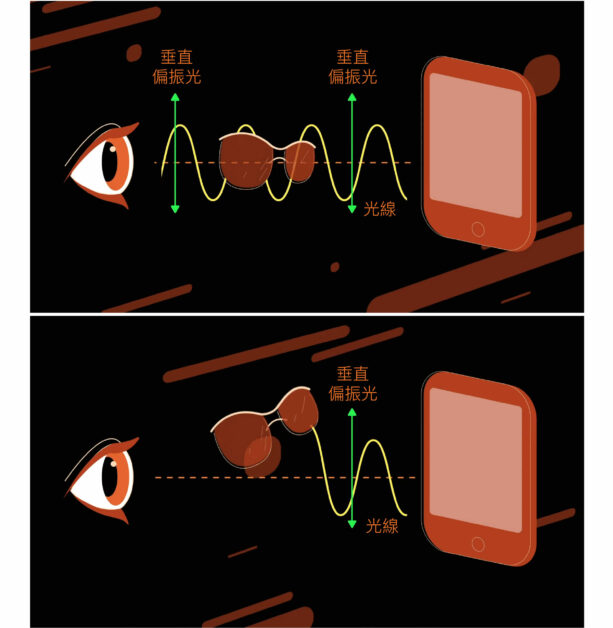
Second, measuring the polarization direction of light can help scientists understand the magnetic field around the black hole. Because the plasma near the black hole has a magnetic field, the polarization of the light emitted by these plasmas is usually perpendicular to the magnetic field. By obtaining polarized light data from the observation results, scientists can analyze the black hole’s magnetic field. So, how to interpret the “texture” of this “Danish doughnut” photo?
The so-called “texture” refers to the specific polarization direction of the light surrounding the black hole. But why is the polarization direction of light so special? According to the latest research, the rotation axis of the black hole in the center of the M87 galaxy points to outer space and away from the earth. Observing the black hole from the surface, its rotation direction is clockwise, and the polarization direction of the surrounding light becomes counterclockwise (because it must be The direction of the magnetic field is vertical), that is, the “texture” similar to the Danish doughnut in the photo. Please see the picture below.
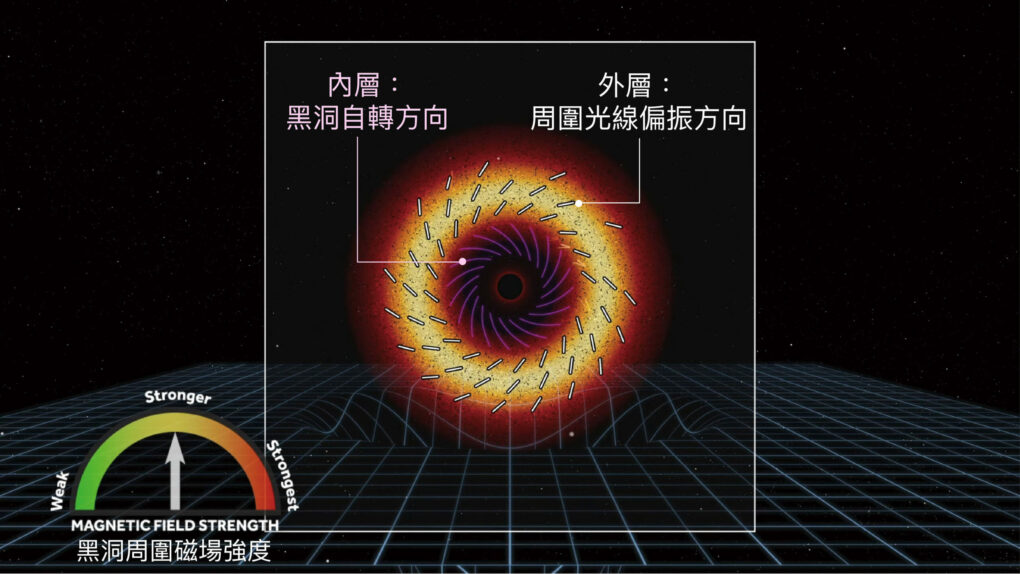
After understanding the surrounding magnetic field from polarized light, scientists can further analyze black holes. Scientists currently know that the black hole in the center of the M87 galaxy has a long and straight jet, which extends from a distance of about 0.01 light-years from the side of the black hole to thousands of light-years away. It takes a huge amount of energy to make the jet flow across such a huge space while being able to stay straight. Astronomers speculate that this may be due to the magnetic field around the black hole.
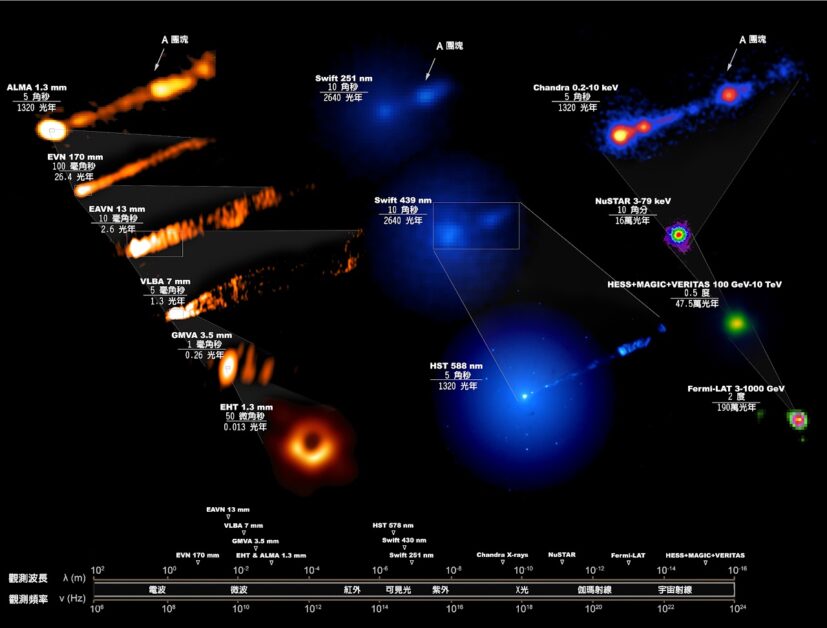
The polarized light image of the M87 black hole may seem to be just a relatively clear “doughnut”, but in fact it is very difficult to obtain the polarized light image of the black hole. This polarized light image and the first black hole photo released in 2019 are from the same observation, but it takes more time to process the data. Therefore, the 2019 image only shows the light intensity around the black hole, while the polarized image will not be released until 2021.
Satoshi Matsushita explained that because the polarization ratio of the light near the black hole is usually less than 10%, the polarization signal is only about one percent of the light intensity, which is very weak. Moreover, all data must be carefully calibrated to remove the polarization generated by the instrument to ensure that the signal comes from celestial bodies. Each telescope used in the observation has different characteristics. Astronomers need to ensure that all data are corrected, which is a very difficult task.
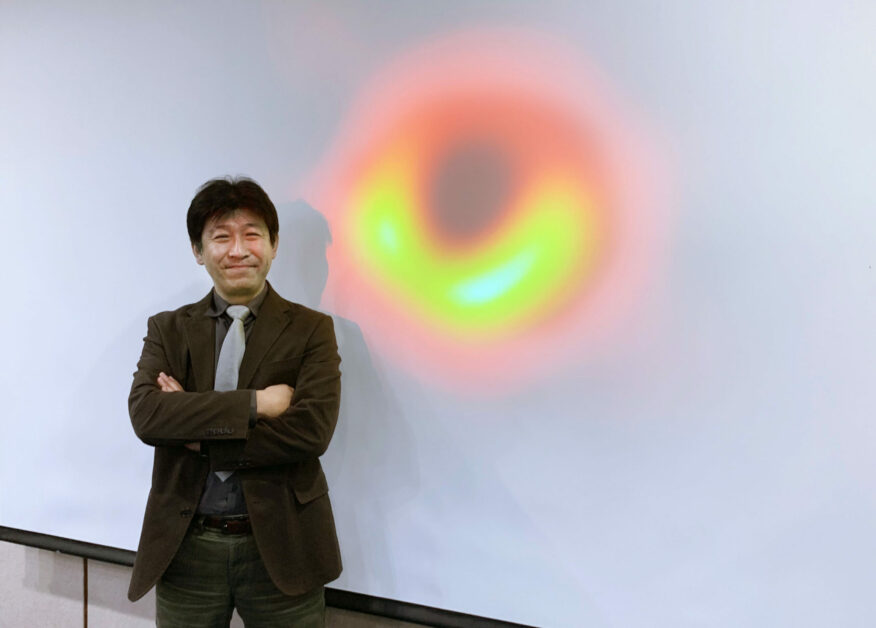
The contribution of the Taiwan team in black hole observation
Matsushita Satoshi pointed out that Taiwan has made a significant contribution to black hole observation. The currently announced black hole images are from observations made in 2017 and were jointly completed by seven telescopes. Taiwan has participated in the operation of three of them, namely the Atacama Large Millimeter and Submillimeter Wave Array (ALMA), and the Submillimeter Wave Array (ALMA). Wave Array (SMA) and Maxwell Telescope (JCMT). In addition to the Greenland Telescope (GLT), which was successfully launched in 2018, Taiwan has contributed a total of 4 telescope operations and instrument technology.
In terms of data analysis, Taiwan’s research team is also very important. Satoshi Matsushita specifically mentioned the contribution of Park Jong-ho, a postdoctoral researcher at the Institute of Astronomy, Academia Sinica. He was responsible for writing data processing programs and completing very difficult calibration tasks, so this polarized image was produced. In addition, Professor Guo Zhengyu from Sun Yat-sen University and Professor Bu Hongyi from Taiwan Normal University participated in this research. The Academia Sinica’s participants in EHT include Keiichi Asada’s participation in the scientific committee, Geoffrey Bower as the EHT project scientist, and Satoshi Matsushita himself leading the work team.
Matsushita Satoshi said that the key to Taiwan’s participation in EHT is that “we have the world‘s cutting-edge technology in Taiwan”, so it has a relatively large influence on foreign research institutions.
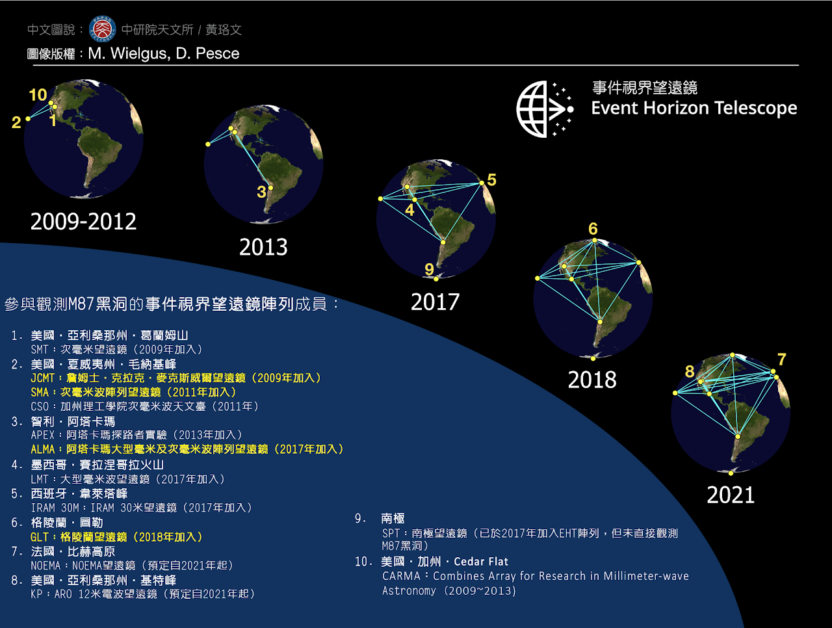
The next step in taking black hole images?
The mission of the Event Horizon Telescope (EHT) is not to close the work when the black hole is photographed. As more instruments come online, it is expected that more black holes will be revealed in the future.
The initial observations in 2017, which are currently published black hole images, used a total of 7 antennas. In 2018, the Greenland Telescope began to join. Due to the distance between Greenland and other antennas, the baseline of the observation is elongated, so the resolution can be increased by about 50%.
In April 2021, the Event Horizon Telescope completed another observation. This time, the Kitt Peak National Observatory in the United States and the Northern Extended Millimeter Array (NOEMA) in France have been added, and the resolution and sensitivity of observation have been improved.
Matsushita Satoshi explained that the currently published black hole images only see the magnetic field next to the black hole. The new observations are expected to detect the magnetic field of the surrounding gas and help us understand the relationship between black holes, magnetic fields and jets. Scientists are intensively analyzing this batch of data, looking forward to good results.
In addition, EHT is currently testing higher frequency observations. Originally, we observed 220 GHz radio waves (wavelength 1.3 mm). After a few years, we will have the opportunity to make observations at 345 GHz (wavelength 0.87 mm) for all antennas. The wavelength is nearly half shorter than before, and the spatial resolution will be significantly improved.
The “doughnuts” we see so far have a resolution of only 3×3 pixels. With the addition of the Greenland Telescope in 2018, the resolution can reach 5×5 pixels. After the frequency is increased to 345 GHz in the future, it can be increased to 7×7 or 8×8 pixels.
There is another hope that the Greenland Telescope will be moved to the mountain, and the weather conditions will be better, and there will be opportunities for higher frequency (660 GHz) observations, and the resolution can be increased to 15×15 pixels. Electromagnetic waves with frequencies as high as 660 GHz are usually absorbed by water vapor and need to be observed in places with little water vapor. Even Hawaii has such conditions for only a few days. Matsushita Satoshi said that Chile is high and dry enough, and Greenland is cold enough to meet the observation conditions.
High-frequency observation is a next-generation project, and no one is sure of success yet, but Satoshi Matsushita sees it positively. He said that when the EHT was first organized, “Everyone said that it was impossible to take black hole images, but we made it possible.”
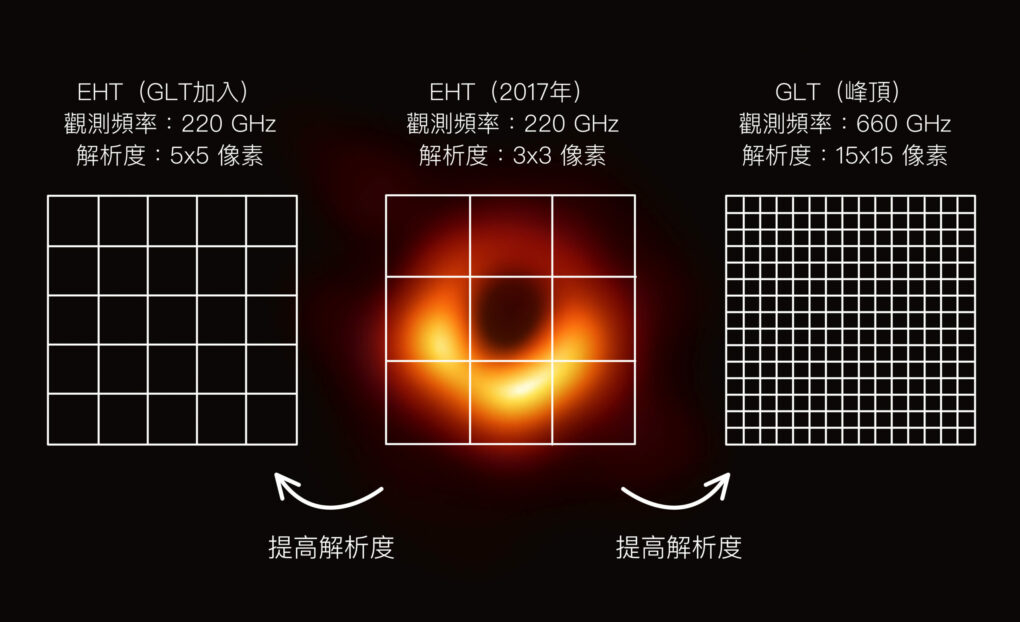
Why pursue high-resolution images?
Matsushita Satoshi explained that, according to the theoretical model, black holes should have many more detailed structures, but they are still blurred in the currently published images. Once you have a higher-resolution image, you have the opportunity to identify the precise location of the event horizon and distinguish between the outflow and inflow gas. The source of black hole energy is the inflowing gas. High-resolution observations can tell us how the black hole eats the gas and the role of the magnetic field in it.
Not only that, the radius and mass of a black hole have a simple linear relationship. If the radius of a black hole can be accurately measured, one can understand how the black hole grows, and even speculate how the black hole of the early universe was born. In addition, the rotation of the black hole drags time and space, causing slight changes in the image, which can be distinguished by high-resolution observations.
Matsushita Satoshi said: “The direct image of the black hole opens up a new field of astronomy and physics. This is not the end, but the beginning.” The “doughnut” image we are seeing is just the beginning, and the future is still exciting.
Reference
- “Move the telescope to Greenland? ! “The Crazy Astronomer Who Observes Black Holes.”
- “Shaky M87 Black Hole: A First Look at Black Hole Dynamics”, Institute of Astronomy and Astrophysics, Academia Sinica.
- “Global Telescope Joint Observation of Famous Black Holes”, Institute of Astronomy and Astrophysics, Academia Sinica.
- Event Horizon Telescope Collaboration, Akiyama, K., Alberdi, A., Alef, W., Asada, K., Azulay, R., Baczko, A. K., Ball, D., Baloković, M., Barrett, J., Bintley, D., Blackburn, L., Boland, W., Bouman, K. L., Bower, G. C., Bremer, M., Brinkerink, C. D., Brissenden, R., Britzen, S., Broderick, A. E., . . . Zhang, S. (2019). First M87 Event Horizon Telescope Results. V. Physical Origin of the Asymmetric Ring. The Astrophysical Journal Letters, 875(1), L5.
- Event Horizon Telescope Collaboration, Akiyama, K., Algaba, J. C., Alberdi, A., Alef, W., Anantua, R., Asada, K., Azulay, R., Baczko, A. K., Ball, D., Baloković, M., Barrett, J., Benson, B. A., Bintley, D., Blackburn, L., Blundell, R., Boland, W., Bouman, K. L., Bower, G. C., Boyce, H., . . . Zhao, S. S. (2021). First M87 Event Horizon Telescope Results. VIII. Magnetic Field Structure near The Event Horizon. The Astrophysical Journal Letters, 910(1), L13.

.jpg)
